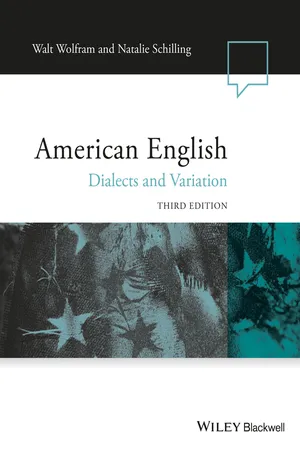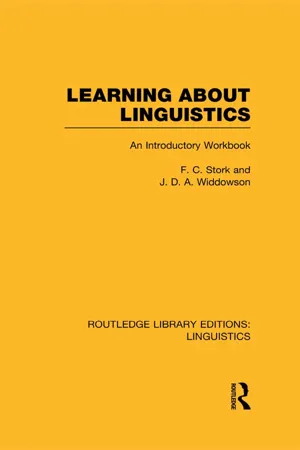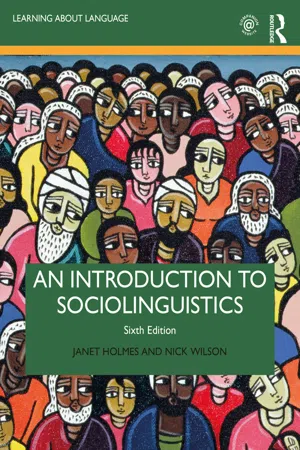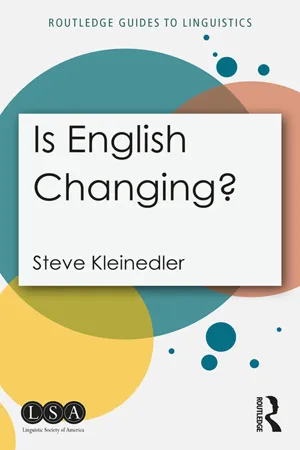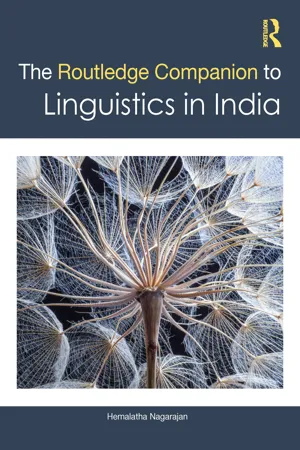Languages & Linguistics
Social Dialects
Social dialects refer to variations in language use that are associated with particular social groups, such as those based on region, ethnicity, or socioeconomic status. These variations can include differences in vocabulary, pronunciation, and grammar. Social dialects are influenced by factors such as social identity, cultural practices, and historical developments, and they play a significant role in shaping communication and language diversity within a society.
Written by Perlego with AI-assistance
Related key terms
10 Key excerpts on "Social Dialects"
- eBook - ePub
American English
Dialects and Variation
- Walt Wolfram, Natalie Schilling(Authors)
- 2015(Publication Date)
- Wiley-Blackwell(Publisher)
When we live a certain way, we are expected to match that lifestyle with our talk. And when we don’t match people’s expectations of how we should talk, the incongruity between words and behavior also becomes a topic for conversation. Language differences are unavoidable in a society composed of a variety of social groups. They are a “fact of life.” And, like other facts of life in our society, they have been passed down with a peculiar mixture of fact and fantasy. 1.1 Defining Dialect Given the widespread awareness of language differences in our society, just about everyone has some understanding of the term DIALECT. However, the technical use of the term in linguistics is different from its popular definition in some important but subtle ways. Professional students of language typically use the term “dialect” as a neutral label to refer to any variety of a language that is shared by a group of speakers. Languages are invariably manifested through their dialects, and to speak a language is to speak some dialect of that language. In this technical usage, there are no particular social or evaluative connotations to the term – that is, there are no inherently “good” or “bad” dialects; dialect is simply how we refer to any language variety that typifies a group of speakers within a language. The particular social factors that correlate with dialect diversity may range from geographic location to complex notions of cultural identity. Furthermore, it is important to understand that socially favored, or “standard,” varieties constitute dialects every bit as much as those varieties spoken by socially disfavored groups whose language differences are socially stigmatized - eBook - ePub
- F.C. Stork, J.D.A. Widdowson(Authors)
- 2014(Publication Date)
- Routledge(Publisher)
dialect is most often used in respect of differences which result from geographical situation, but sociological features are equally important and they play a particularly dominant role in varieties of English. A dialect is a variety of language, which is either regional or social in origin (or a combination of these) which is spoken by certain members of the speech community.In England there are many regional dialects which have an equally long history going back to Old English times and the coming of the Angles, Saxons and Jutes in the fifth century A.D. In fact the modern regional dialects have all evolved from the four regional dialects of Old English. In everyday language the term dialect is often thought of as being concerned with rural uneducated speech. Dialectology, however, as a branch of linguistics is concerned with all regional types of speech in towns and cities as well as in villages and in rural communities. The so-called ‘standard language’ itself is nothing more than a regional dialect which has taken on its prestigious role as a result of various geographical, cultural, political and social pressures. Regional dialects can differ from each other in three principal ways:(1) phonology (2) grammar (3) lexisIn the twentieth century the most important distinctions between regional varieties of speech in English are to be found on the phonological level. Some dialectologists make a useful distinction between ACCENT , which is a variety of language differing from other varieties merely on the level of phonology, and DIALECT which differs from other varieties in grammar and lexis as well as phonology.In the British Isles geographical and social factors overlap in the various dialects. As a general rule speakers of high social or educational status from all parts of the country tend to modify their speech towards the norms of Southern British English. The term standard English is often used to refer to written forms of the language which conform to the patterns and grammatical norms of the socially accepted speech variety based on Southern British English. On the phonological level the pronunciation of educated speakers from that area is also taken as the standard and is often referred to as RECEIVED PRONUNCIATION (RP) . Both standard English and Received Pronunciation refer to those kinds of English which are typical of educated speakers from London and the south east and are free from other regional variations. They are also used as models for teaching English to non-native speakers. What is regarded as ‘standard’ or ‘received’ cannot be defined in absolute terms, not least because it is the nature of language to be in a constant state of change. It is therefore impossible to legislate for what is acceptable or unacceptable for more than a brief period of time. Even in those countries where there is an Academy or other official body for laying down standards of language (e.g. L’ Académie Française in France) the everyday speech of the people is scarcely influenced by its prescriptive pronouncements. English has no such official body and what is regarded as standard is based on a consensus of opinion among its educated speakers. There are therefore varieties of standard English which vary from place to place and from time to time. Educated people from areas outside the south east may speak modified forms of standard English which might be called regional standards. Such regional standards, however, are largely a question of accent: i.e. they differ from each other mainly on the phonological level. The speech of BBC announcers from Bristol may include the West Country [r] sounds and an announcer from Manchester may use the northern [a] and these minor variations alone mark their pronunciation as different from RP - eBook - ePub
- Gerard Van Herk(Author)
- 2012(Publication Date)
- Wiley-Blackwell(Publisher)
Linguists use the principle of mutual intelligibility to distinguish a language from a dialect, but speakers and governments may apply different criteria. Sociolinguists label distinct subsets of a language as dialects or varieties, reserving terms like slang or accent for specific linguistic domains. We study language in use, at the level of the social group. Depending on our research interests and assumptions, we may define the social group as a speech community, social network, or community of practice, each of which implies a greater level of speaker agency in linguistic interactions.Where to next?ExercisesThere are two big (and possibly competing) pulls in how sociolinguists consider language use these days. One approach, which we might label the telescope view, uses quantitative methods (and improving technology) to conduct large-scale studies of large data sets. People using this approach, influenced by the growing discipline of corpus linguistics , work to develop statistical methods, automated data extraction and analysis, and database building methods. This approach is especially well suited to investigating language changes that are widespread or that occur over a long period of time. Another approach, which we could call the microscope view, uses mostly qualitative methods to conduct small-scale, intensive studies of particular communities of practice. People using this approach, influenced by anthropology, work to develop conversation analysis tools and to identify locally significant social distinctions. There’s some hope, though, that the two approaches can work together. For example, the (telescope) Ottawa Intensifier Project found quantitative evidence that nerds, in particular, actively distance themselves linguistically from other youth subcultures, confirming the findings of Bucholtz’s (1999) well-known (microscope) study of nerd girls in high school.1. Ask people if they can think of any inside jokes, things that only make sense (or are funny) to a small group of people who know the “back story.” These might include strange definitions, things that refer back to a particular event, or unusual pronunciations of a word (for some reason, lots of families seem to have at least one of these that results from how somebody in the family pronounced something when they were very young). Write them down; look for common traits among the things people tell you. - eBook - ePub
- Janet Holmes, Nick Wilson(Authors)
- 2022(Publication Date)
- Routledge(Publisher)
So far we have been discussing accents and dialects as if the linguistic features which identify them were stable, fixed and absolute. But, as with the notion of distinguishable languages, this is just a convenient fiction. The way people speak is characterised by patterned variation. The patterns are fascinating and indicate the social factors which are significant in a society. To illustrate this point, the rest of this chapter will discuss the relationship between speech and social status or class.Caste dialects
People can be grouped together on the basis of similar social and economic factors. Their language generally reflects these groupings – they use different Social Dialects. It is easiest to see the evidence for Social Dialects in places such as Indonesia and India where social divisions are very clear-cut. In these countries, there are caste systems determined by birth, and strict social rules govern the kind of behaviour appropriate to each group. The rules cover such matters as the kind of job people can have, who they can marry, how they should dress, what they should eat, and how they should behave in a range of social situations. Not surprisingly, these social distinctions have corresponding speech differences. A person’s dialect is an indication of their social background.There are quite clear differences in Indian languages: for example, between the speech of the Brahmins and non-Brahmin castes. The Brahmin word for milk in the Kannada language, for instance, is haalu, while non-Brahmin dialects say aalu. The Tamil Brahmin word for sleep is tuungu, while non-Brahmin dialects use the word orangu. - eBook - ePub
- Steve Kleinedler(Author)
- 2018(Publication Date)
- Routledge(Publisher)
Society and culture
Each of the previous chapters was an overview of a linguistic subfield and examined how English has changed in that subfield.7.0 IntroductionThis chapter deals with SOCIOLINGUISTICS , the study of the influence of society and culture on language, including the way society and culture cause language change. Sociolinguists analyze the phonological, morphological, syntactic, semantic, or pragmatic features of one or more social groups (such as ones categorized by gender, economic class, race, ethnicity, or age). Some sociolinguists document how these linguistic features are manifested in the speech of a particular social group, others compare and contrast similarities and differences across multiple groups, still others document linguistic changes that certain groups innovate.Obviously, no social or cultural group is a monolithic entity. The phonological features of the working class in Pittsburgh are different from those of the working class in Manchester, Baltimore, or Adelaide, and these phonological features change over time.REGIONAL VARIATION (also called DIALECTOLOGY ) is the study of how a language varies from region to region. For languages spoken worldwide like English, the analysis can be global or within a country: for example, documenting a variety of English spoken in the bayous of Louisiana, or comparing English spoken in southwestern England to that of Yorkshire.7.1 Language and varietyImagine two people speaking to each other. Could you tell if they’re speaking the same language, different dialects of the same language, or different languages? Let’s examine what this question means. - eBook - ePub
- Hemalatha Nagarajan(Author)
- 2022(Publication Date)
- Routledge India(Publisher)
The static factors are aspects like region, class, caste, gender, etc., of the speaker, which remain unaltered in all circumstances. 1 There are also some dynamic factors that condition our language use. These are factors like the subject matter, the medium of communication (spoken or written, e-mail, or text message), and the addressor–addressee relationship, fashions in language use, etc. The static factors mostly lead to dialects, and the dynamic factors contribute to differences in registers. A. Dialects Dialects are varieties of a language spoken by a group of people and are characterized by some systematic phonological, morphological, syntactic, or semantic features. Dialects are classified under two heads: regional and social. Figure 7.1 Dialects: regional and social Regional dialects differ according to the region they are spoken, whereas Social Dialects refer to the social structure and the differences in language that arise because of this. It could be in terms of race, social class, or caste differences. Wardhaugh (1986 : 22) defines language varieties, such as dialects, in terms of a specific set of linguistic items or human speech patterns (presumably, sounds, words, grammatical features) which we can uniquely associate with some external factors (presumably, a geographical area or a social group). Sociolinguists study the linguistic features of dialects and create dialect maps. A dialect is demarcated from others by a linguistic boundary called an isogloss. Frequently, however, several isoglosses are grouped approximately together into a bundle of isoglosses. Isoglosses of various linguistic phenomena usually cross and interweave creating dialect maps - eBook - ePub
- Rob Penhallurick(Author)
- 2018(Publication Date)
- Bloomsbury Academic(Publisher)
A language such as English varies according to its geography. At the same time, it will vary according to social class – not all speakers from the same locality will speak the same dialect of English uniformly if those speakers vary in social class. The speech of the locality as a whole can vary along a non-standard to standard continuum that correlates largely with social stratification. Similarly, the local speech may vary in regular patterns that become apparent when the linguistic data is matched with information about the age, sex, and ethnicity of speakers. What is more, each individual dialect speaker will tend to vary his or her own speech according to the social situation, in relation to such factors as the perceived informality/formality of the context and the social class of the other interlocutors. We each may pronounce any given word differently not only in comparison to other speakers but also according to whether we are speaking to friends or to strangers, whether we are in a bar or at home or in work or in a classroom, and so on. If the investigator of dialect ignores such social and stylistic correlations, then it is likely that the data will appear to contain what looks like quite random or ‘free’ variation. But when the sociolinguistic correlations are made, this random variation might assume regular patterning, and its causes are revealed. The variation then appears not random but structured. What we see is ‘orderly’ or ‘structured heterogeneity’, to use the terms first developed by Weinreich, Labov and Herzog (1968) in a paper given at a conference at the University of Texas in 1966. For as long as dialectologists focused on the speech of one class (rural working class) and one age-group (elderly), it was to some extent defensible to neglect these correlations. However, when the focus expanded it was time for the methods, aims, and general approach to evolve in new directions. The notion of structured heterogeneity is central to the sociolinguistic way of doing dialect study, as Weinreich, Labov and Herzog stated in 1966: ‘The key to a rational conception of language change – indeed, of language itself – is the possibility of describing orderly differentiation in a language serving a community’ (1968, no page number, online version). (In the process some aspects of the older dialectological approach became newly neglected, for a while at least. As noted above, the sociolinguistic approach in its early days was less concerned with vocabulary, with dictionaries and atlases and national-scale projects, and with history.) - eBook - ePub
- Kirsten Malmkjaer, Kirsten Malmkjaer(Authors)
- 2009(Publication Date)
- Routledge(Publisher)
community of practice (Meyerhoff 2002) models being applied depending on the nature of the particular enquiry – the latter two represent more recent approaches, with social networks emphasising the role that speakers’ social embeddedness into local communities plays in the maintenance of traditional dialect forms, and community of practice approaches highlighting the linguistic customs that emerge when people come together to mutually engage in a particular task. These levels of contextual analysis have enabled social dialectology to engage in research at very different scales, from, for example, a consideration of the extent to which the world’s Englishes share linguistic features (Szmrecsanyi and Kortmann 2009) right down to the linguistic practices of a small group of ‘uncool’ girls in a Californian high school (Bucholtz 1999).Rural versus urban
Given that one of the main aims of social dialectology was to discover the orderly heterogeneity of the speech community, searching for (and finding) such order in cities – which seemed like some of the most socially turbulent, heterogeneous and diverse communities in the world – was always going to be a powerfully persuasive strategy for the new discipline. Consequently, the abandonment of traditional dialectological data collection methods went hand in hand with the abandonment of the investigation of rural areas (with an important early exception). In the popular imagination, cities were sites of diversity, conflict, contact, complexity, variation, change. Rural areas, by contrast, are often portrayed as the insular, the isolated, the static, and in some parts of the West as (attractive) idylls of peace, tranquillity and safety. That this urban– rural dichotomy is rather problematic (see, further, Britain, 2009b) was actually amply demonstrated in the very earliest social dialectological work – in Labov’s (1966, 2006) analyses of both urban New York City and rural Martha’s Vineyard (Labov 1963/1972). Labov argued that the Lower East Side of New York City represented ‘a much more complex society’ (Labov 2006: 3) than Martha’s Vineyard, although ultimately social diversity in the city was distilled down to the variables of age, class, ethnicity and gender – factors which are also some (but not all) of the salient dimensions of social diversity in Martha’s Vineyard (Labov 1972: 4–6). There, in this largely rural community, if we set aside the White Vineyarders, residents of Portuguese, Native American and other miscellaneous ethnicities make up half if not more of the population (Labov 1972: 6), even before we take into consideration a small resident population coming originally from the Mainland and large numbers of tourists. In addition these populations are not distributed geographically evenly across the island, and are, naturally, engaged in a diverse range of socioeconomic activities. As the results of Labov’s analysis demonstrated, the community showed considerable sociolinguistic diversity with respect to age, location, occupation, ethnicity, orientation towards the island as well as desire to stay on the island or leave (Labov 1972: 22, 25, 26, 30, 32, 39). In terms of social and linguistic structure, Martha’s Vineyard hardly fits the rural stereotype of quiet and sleepy pastoralism, or of traditional dialectological NORMs, as Labov’s analysis so succinctly showed. By contrasting a highly rural area with a highly urban one, his work can be seen as a clear demonstration that there are large-scale social(-linguistic) processes which are perhaps most obviously and vividly expressed in cities but are not confined politically, sociologically or epistemologically to an urban context (see, further, Britain 2009b). - eBook - ePub
- W.R. O'Donnell, LORETO Todd(Authors)
- 2013(Publication Date)
- Routledge(Publisher)
Similarly, we should expect the distribution of individual vocabulary items in relation to the social scale to be a matter of statistical frequency rather than absolute necessity at any given point on the scale. Furthermore, relative frequencies would undoubtedly vary from item to item. One would not, therefore, anticipate the same social distribution for dialect items such as, for example, ‘our kid’, ‘daft’, ‘boyo’, ‘poorly’, ‘bairn’, ‘snicket’ (a narrow passage between houses), any more than one would expect to find the same regional distribution for them.Language variation in the social dimension, then, is essentially similar in nature to regional variation. At one end of the social scale in any given locality the most likely form of English is local dialect English, at the other end is Standard English, with, in between, grammar, vocabulary and accent varying continuously. Spoken English, therefore, has to be perceived as a three-dimensional continuum, within which it is not possible, except arbitrarily and artificially, to identify ‘dialects’ It is for this reason that we have not written of ‘dialects’, but of ‘dialect’ (singular); by which we have intended to identify that kind of English which is essentially spoken, in contrast with ‘Standard’ English, which, as we pointed out earlier, is primarily a written form of the language.Being primarily written, Standard English is not associated with any particular accent. In the social dimension, therefore, what usually happens with regard to accent is that variation up the social scale is in the direction of the locally prestigious pronunciation, so that educated speakers in Yorkshire, let us say, or southern Scotland, or New England, or western Australia, regularly speak Standard English with an accent which is recognisably a modified version of that in which the dialect English of the locality is spoken. In Britain, however, there also occurs a non-local accent which is sometimes used with Standard English, though never with dialect English (except, perhaps, for Eliza Doolittle’s). This accent is known to phoneticians as ‘RP’. The initials originally stood for ‘Received Pronunciation’, but the term ‘Received’ in this context is now, at best meaningless, even possibly misleading, and so it is better to stick to the initials. - eBook - ePub
- Martin Montgomery(Author)
- 2008(Publication Date)
- Routledge(Publisher)
Part TwoLinguistic Diversity and the Speech CommunityThe development of labour necessarily helped to bring the members of society closer together by increasing cases of mutual support and joint activity, and by making clear the advantage of this joint activity to each individual. In the short, humans in the making arrived at the point where they had something to say to each other.(Frederic Engels* )Now the whole earth had one language and few words… And the Lord said, ‘Behold they are one people, and they all have one language; and this… [tower reaching to the heavens] … is only the beginning of what they will do; and nothing that they propose to do will now be impossible for them. Come, let us go down, and there confuse their language, that they may not understand one another’s speech.(Genesis 11: 1–9)* Engels, F., ‘The part played by labour in the transition from ape to man in Marx, K. and Engels, F. (1968) Selected Works, London: Lawrence & Wishart.Passage contains an image
Regional Variation within A Speech Community3 Language and Regional Variation: Accent and Dialect In learning a first language the child assumes active membership of society. Initially, of course, the child enters not society as a whole but a particular localized subgroup. In this respect, access to his/her first language is by way of a highly specific network of speaker’s who pass on to the child their own version of the language in question. The child, in effect, does not learn ‘a language’ whole and entire such as Urdu, Swahili, German or English: s/he learns a way of communicating with an immediate social group. For, just as there are extreme and obvious differences between one language and another – between, for example, English, Farsi (Persian), Gujarati, Urdu, Welsh, Serbo-Croat, and German – there are also significant if less obvious differences within languages. Thus there are important distinctions between High and Low German, between Serbian and Croatian, between British and American English. A child growing up somewhere in Britain does not necessarily learn a uniformly standard form of English as a first language. In the first place, it might not be English at all: It might be Welsh or Urdu or Punjabi. And, even if it is ‘English’, it may well be a very different English if learnt in parts of Liverpool, Glasgow, Oxford, or Belfast.
Index pages curate the most relevant extracts from our library of academic textbooks. They’ve been created using an in-house natural language model (NLM), each adding context and meaning to key research topics.
